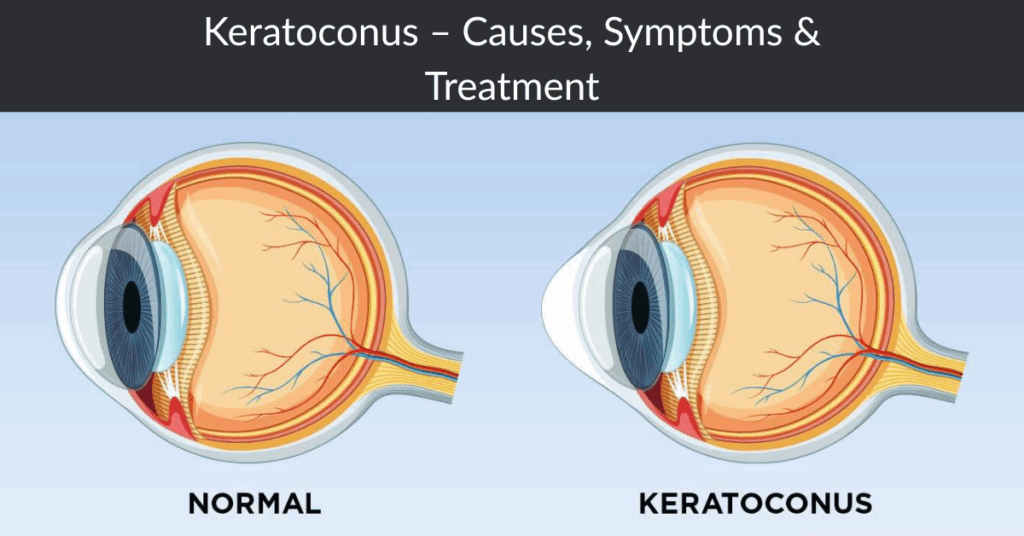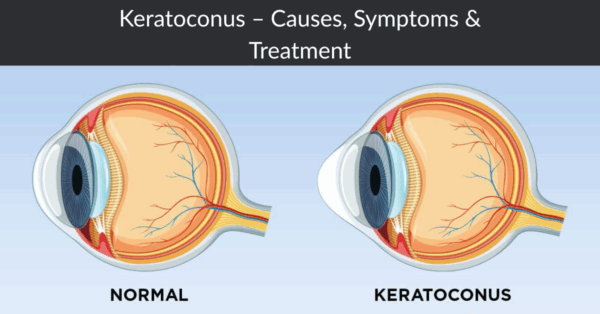Have you noticed your vision getting blurry even with your glasses on? Or do you often find yourself rubbing your eyes, especially if you’re under 40?
If yes, it might be time to learn about Keratoconus — and more importantly, how early diagnosis and expert care at Shroff Eye Centre can help protect your sight for the long term.
For over a century, Shroff Eye Centre has been at the forefront of eye care in India, combining advanced medical technology with compassionate care. Our specialists focus not just on treatment, but on empowering every patient with the knowledge and guidance needed to maintain clear and healthy vision.
What is Keratoconus?
Your cornea — the clear, dome-shaped front part of your eye — helps focus light so you can see clearly.
In Keratoconus, the cornea becomes thin and starts bulging outward into a cone-like shape. This distorts how light enters your eye, leading to blurred, distorted, or fluctuating vision.
The condition usually develops in younger individuals (teens to 40s) and can progress over time if left untreated.
Common Symptoms You Should Watch For
Keratoconus often begins subtly, but early recognition is crucial.
Look out for these signs:
- Blurry or distorted vision
- Double vision in one eye
- Sensitivity to light, especially at night
- Frequent changes in glasses prescription
- Poor vision even with new corrective lenses
If you notice any of these, it’s best to book a comprehensive eye check-up at your nearest Shroff Eye Centre before it progresses further.
Why Does Keratoconus Happen?
The exact cause isn’t fully understood, but several risk factors are known to contribute:
- Frequent eye rubbing – the most common trigger
- Family history – genetics can increase your risk
- Allergies or chronic eye irritation – can lead to rubbing and thinning of the cornea
At Shroff Eye Centre, our specialists not only treat Keratoconus but also educate patients on simple preventive habits — such as managing allergies and avoiding eye rubbing — to help slow its progression.
How We Diagnose Keratoconus
Routine eye exams can sometimes miss early Keratoconus. That’s why Shroff Eye Centre uses cutting-edge diagnostic technology to ensure accuracy and early detection:
- Comprehensive Eye Examination – detailed vision, eye pressure, and structural assessment
- Corneal Topography – creates a 3D map of your cornea to detect shape irregularities
- Pachymetry – measures corneal thickness precisely
- Corneal Biomechanical Analysis – evaluates the strength and flexibility of the cornea
Our team, including Dr. Rushad Shroff and Dr. Dariel Mathur, has vast experience in identifying even the most subtle signs of Keratoconus in its earliest stages.
View full team here
Treatment Options at Shroff Eye Centre
The goal of treatment is twofold — to improve your vision and to stop the disease from getting worse.
At Shroff Eye Centre, all advanced treatment options are available under one roof:
1. Glasses & Special Contact Lenses
In early stages, glasses may help. As the condition progresses, specially designed contact lenses such as rigid gas-permeable or scleral lenses offer better clarity and comfort.
2. C3R (Corneal Collagen Cross-Linking)
A gold-standard treatment to halt Keratoconus progression. Using Vitamin B2 (riboflavin) drops and UV light, this strengthens the cornea and prevents further bulging. The procedure is safe, painless, and stabilizes the cornea long-term.
3. Topography-Guided C3R
An advanced version of C3R that not only stabilizes the cornea but also improves its shape, often leading to sharper vision.
4. Intacs (Corneal Ring Segments)
Tiny ring inserts are placed in the cornea to help flatten the cone and improve visual clarity. This is a minimally invasive procedure with excellent results in selected patients.
5. Corneal Transplant
For advanced Keratoconus where other options no longer help, corneal transplantation offers a safe and effective solution. Our corneal specialists perform these procedures with high success rates and meticulous post-operative care.
Comprehensive Care Beyond Treatment
At Shroff Eye Centre, care doesn’t stop when the procedure ends. We believe long-term eye health comes from consistent follow-up and patient education.
Our post-treatment care includes:
- Personalized lifestyle guidance to protect your vision
- Regular follow-up visits to monitor stability
- Counselling for you and your family, since the condition may have a genetic link
- Easy appointment scheduling and minimal disruption to your daily routine
This holistic approach is why patients across Delhi NCR trust Shroff Eye Centre for reliable, lifelong eye care.
What Should You Do If You Have Keratoconus?
Here are a few simple but vital steps:
- Avoid rubbing your eyes — it can worsen the condition
- Follow your doctor’s treatment plan carefully
- Encourage family members to get screened
- Keep your follow-up visits — even if your vision seems stable
If you’ve already been diagnosed, you can learn more about C3R (Corneal Cross-Linking) procedures at Shroff Eye Centre to understand how we can help preserve your vision.
Take the Next Step for Your Eye Health
If you suspect you have Keratoconus — or if your vision remains blurry despite new glasses — don’t delay.
With timely diagnosis and expert care, you can maintain clear vision for years to come.






 Call us
Call us Email us
Email us





